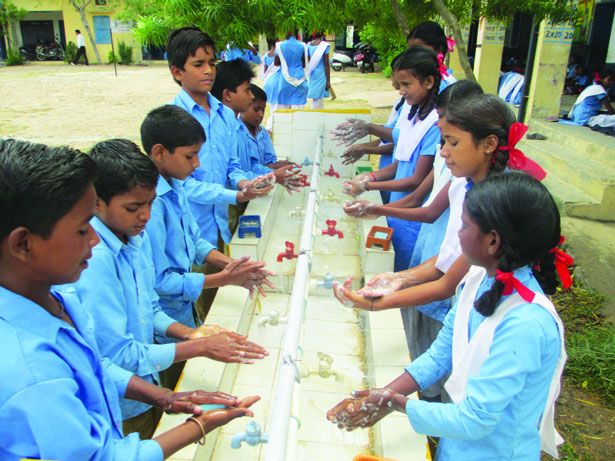The challenges in accessing adequate water supply, sanitation facilities and poor hygiene practices lead to a rise in diseases, causing increased economic burden
Access to hygiene and sanitation facilities is a fundamental human right and one of the key determinants of health. According to the 2017 ‘Household Survey for the Assessment of Toilet Coverage under Swachh Bharat Mission’, 39.9 percent of India’s rural population defecates in open and about 26 percent people do not use soap or detergent to wash their hands afterwards (National Sample Survey 2019). The challenges in accessing adequate water supply and sanitation facilities coupled with poor hygiene practices lead to a rise in diseases which can result in higher economic burden, exceeding investments in hygiene and sanitation systems.
The sixth Sustainable Development Goal is to ‘Ensure availability and sustainable management of water and sanitation for all’ by 2030. Since Water, Sanitation and Hygiene (WASH) programs have a direct impact on health and socio-economic indicators, they have played a central role in improving India’s overall health over the past decades. Hygiene, water and sanitation programs are a proven cost-effective investment for public health.
Ever since Independence, WASH Programs have been synonymous with the country’s public health agenda. Too many lives have been lost to preventable diseases such as malaria, diarrhoea, cholera, smallpox and other infectious diseases — all caused by poor hygiene, sanitation and inadequate water supply. As a result, the Government of India put emphasis on improving health indicators with a focused approach towards water supply and sanitation across the country.
In the 10th five-year plan adopted in 2002, the role of sanitation and hygiene were intrinsically linked to the objectives of reducing Infant Mortality Rate (IMR); Maternal Mortality Ratio (MMR); ensuring completion of five years of schooling for all children by 2007 and providing potable drinking water in all villages.The Swachh Bharat Mission and the Jal Jeevan Mission are two recent government initiatives aimed at improving the supply of clean water and moving the country toward sustainable sanitation standards. While the Swachh Bharat Mission was aimed at achieving universal sanitation coverage, the Jal Jeevan Mission sought to ensure piped water supply for all households in the country; providing a significant boost to the rural water and sanitation industry. According to Lancet’s ‘The Global Burden of Disease’ study, through these efforts India managed to add quality years of life expectancy to its people, indicating a substantial increase in the overall health of the country.
However, given the wide inequalities in the social and economic demographics of the population, India continues to experience mixed progress in terms of hygiene and sanitation-related outcomes.
The economic consequences caused by inadequate access to sanitation has repercussions at multiple levels. Along with loss of GDP, communities suffer due to decreased productivity and increased expenditure on healthcare. A World Bank study on the economic impacts of poor sanitation in India estimated that the country lost the equivalent of 6.4 percent of GDP due to inadequate sanitation. Over 70 percent of it (`1.75 lakh crore) was accounted for by premature mortality and health-related costs.
While social impacts are difficult to quantify, some risks are often exacerbated, affecting the most vulnerable groups including women, children and people with disabilities. For example, poor pregnancy outcomes, maternal mortality, violence and psychological stress are some of the serious consequences of lack of access to clean water and sanitation among women and girls. Inadequate access to WASH can also lead to vulnerability, rape and attacks, and the fear of such assaults can prohibit women and children from using toilets and sanitary facilities outside their homes at night. Similarly, problems of dignity, safety and privacy to maintain good hygiene get compounded for disabled persons as they experience increasing feelings of disgust, fear of violence, injury and shame due to lack of proper hygiene services.
To overcome the issues related to hygiene and sanitation and prevent its negative socio-economic impacts, communities governments, private sector and development partners must make collaborative efforts towards innovative solutions. Governments and supporting agencies need to foster innovation, especially from the commercial sector, to make hand hygiene a universal practice in all contexts. To tackle issues of shortage of water, inaccessibility and unavailability of hand washing facilities and soaps, new solutions are urgently required. Multi-stakeholder collaborations in such situations assume an important role in providing market knowledge and recommendations on enhancing hand hygiene and strengthening WASH facilities.
A collaboration between the World Bank, UNICEF, Johns Hopkins University, USAID and Unilever to form a Public-Private Partnership for Handwashing in 2001 is a case in point. More notably, Unilever has been involved in tackling epidemics such as cholera and has been able to reach over 1.2 billion individuals with programs and awareness campaigns through their Hygiene and Behaviour Change Coalition partnerships. Through close collaborations with Government/ public enterprises, HBCC has been able to advocate for hand and surface hygiene among the vulnerable slum populations even during the COVID-19 pandemic.
Interventions to promote hand hygiene should also be founded on a thorough understanding of what people care about, and should incorporate appropriate social norms to help build sustainable habits. The emphasis needs to move towards a transformative approach focusing on needs of the community, going beyond the benefits of WASH in sanitation research and programming and eliminating the less safe forms of sanitation. Projects like NISHTHA, USAID’s flagship health system strengthening project being implemented by Jhpiego in partnership with Unilever, support various state governments in leveraging the Health and Wellness Centres (HWCs) platform under Ayushman Bharat. One of the key aspects of this project is the health and wellness session, where local communities are educated on the importance of healthy hygiene. Considering the local context, this project leverages on existing limited resources and funds to establish handwashing corners and appropriate social norms to strengthen handwashing behaviours.
Transformative approaches to hygiene and sanitation require stronger governance, management and increased accountability. There is a need to build capacities of health workers and sanitation workers, create mass awareness among the larger public and collaborate with the private sector and other partners for investing in the area of WASH. This would not only ensure access to sanitary facilities to households but would also empower people to take sustained action at local levels.
Overall, investments in toilet usage, hygiene promotion, increased access to potable water, and effective waste management are estimated to save India $32.6 billion (`1.48 trillion) or $29 (`1321) per capita, according to a Water and Sanitation Program report. Improved sanitation yields several economic benefits, including direct benefits such as avoiding illnesses (the sum of money saved on healthcare expenses), indirect economic benefits such as fewer sick days and a longer lifespan because these benefits permit people to work more. As estimated by WHO, every dollar invested in hygiene and sanitation provides a return on investment for the society of $5.50 due to lower health costs, increased productivity and fewer premature deaths. Therefore, it is imperative to carefully shape policies and regulations that prioritize and adequately fund hygiene and sanitation.
(Dr Swati Mahajan is chief of party, USAID-NISHTHA project and leads the comprehensive primary healthcare portfolio for Jhpiego. Krithika Murali is leading the communication, documentation and knowledge management portfolio for USAID-NISHTHA project, implemented by Jhpiego. The views expressed are personal.)


























